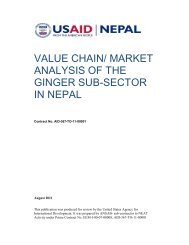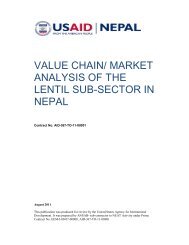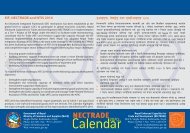value chain/ market analysis of the orthodox tea sub ... - Nepal Trade
value chain/ market analysis of the orthodox tea sub ... - Nepal Trade
value chain/ market analysis of the orthodox tea sub ... - Nepal Trade
Create successful ePaper yourself
Turn your PDF publications into a flip-book with our unique Google optimized e-Paper software.
Figure 2: Production trend <strong>of</strong> <strong>tea</strong> from 2000 to 20102000015000Tons1000050000Small Farmers(Orthodox) Estates (Orthodox) Small Farmers (CTC) Estates (CTC)Source: NTCDB, 2011There was a significant increase in <strong>the</strong> production <strong>of</strong> CTC <strong>tea</strong> from 5,537 tons in 2000/01 to14,471 tons in 2009/10, whereas production <strong>of</strong> <strong>orthodox</strong> <strong>tea</strong> has increased from 1,100 tons to2,135 tons in <strong>the</strong> same periods. In <strong>Nepal</strong>, small farmers have a greater share <strong>of</strong> <strong>orthodox</strong> <strong>tea</strong>production than <strong>the</strong> state owned <strong>tea</strong> states. Figure 3 shows <strong>the</strong> production share for <strong>orthodox</strong><strong>tea</strong> and CTC <strong>tea</strong> in <strong>Nepal</strong> in 2009/10.Figure 3: Percentage share <strong>of</strong> Orthodox <strong>tea</strong> production and CTC <strong>tea</strong> production in 2009/10Orthodox Tea13%CTC Tea87%CTC TeaOrthodox TeaSource: NTCDB, 2011Tea has been mostly cultivated in <strong>the</strong> eastern region <strong>of</strong> <strong>Nepal</strong>. Figure 4 represents <strong>the</strong> major<strong>tea</strong> producing districts with plantation areas and quantities produced in 2009/10.Value Chain/Market Analysis-Orthodox Tea 7






